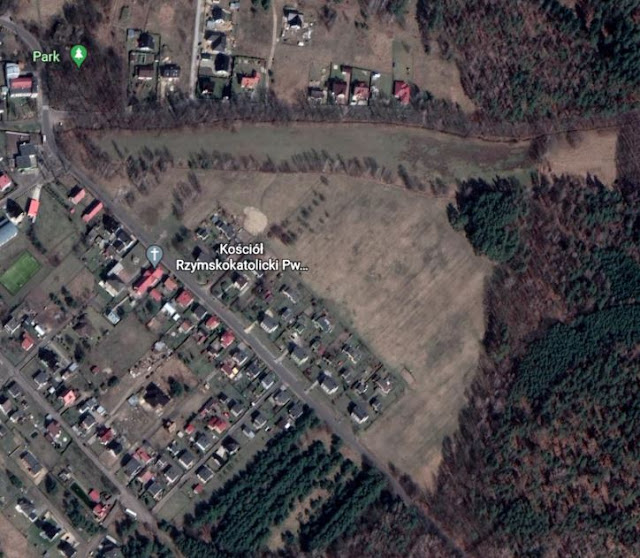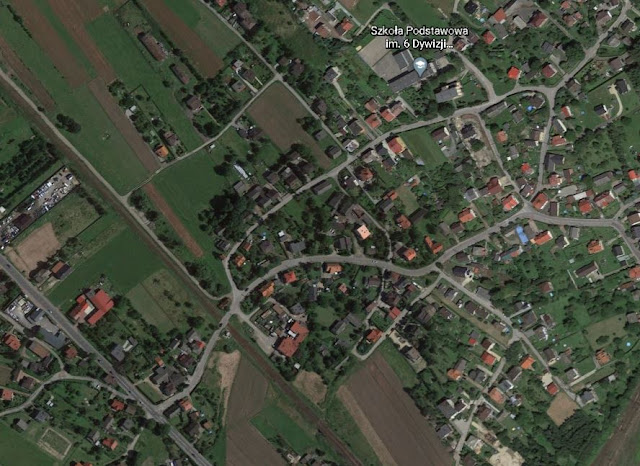Althammer
Althammer is often identified as being located in Stara Kuźnia near Halemba, about ten kilometres west of the Polish city of Katowice.
That would seem to identify this site here:
There is at least one ruined brick building at Stara Kuznia (see picture below), on the outskirts of a park (shown by green marker on the picture above), which would seem to indicate that there was some presence here, but this site is not the main site as discussed by the main sources.
Other sources, specifically subcamps-auschwitz.org locate the camp on ul Skargi, which is a district of Halemba, which is a considerable distance away from Stara Kuznia, past Gleiwitz, to the east.
The camp was commanded by SS-Oberscharführer Johann Mirbeth and was established by the SS in September 1944 with the aim of supplying slave labour for the construction of the Walter thermal power plant nearby. The camp had originally held Italian prisoners of war. The first batch of 30 prisoners arrived in a truck from Auschwitz main camp. The first task was to surround the camp with a barbed wire fence and four watchtowers. Most of the work subsequently included bricklaying, transportation of materials and the construction of a sewage system. The latter meant that prisoners had to stand for long periods of time in water without any rubber boots. Other tasks involved the construction of a railway siding, the digging up of potatoes, unloading of railway wagons, working in the SS guards kitchen, cleaning camp rooms and sweeping yards and paths and constructing a new kitchen.
By January 1945 the camp held 486 Jewish prisoners, most of whom came from the Lodz ghetto. Others came from Hungary, France and Greece. There were some German prisoners in the camp also, but they were treated in a privileged manner, holding a higher ranking in the camp inmate hierarchy. There was also one Roma.
Most of the prisoners were treated extremely harshly, suffering abuse and malnutrition. There were regular roll calls, during which prisoners were made to stand for long periods of time. Any prisoner found to be in possession of contraband was beaten with a whip or a rubber baton.
The fact that almost none of the work tasks carried out were mechanised tended to exacerbate this situation, along with lack of protective clothing. This resulted in serious illness among at least 30 percent of the prisoner population, including an outbreak of typhus. There was an infirmary on site, supervised by orderly SS-Sturmmann Kisel. Dead prisoners bodies were stored in the camp latrine for a while before being removed to Auschwitz main camp where they were burned in the crematoria.
Numerous prisoners were tortured and murdered by camp guards and also by camp commandant Mirbeth himself. These crimes remain unpunished.
The camp was partly evacuated on 19th January 1945. Around 400 prisoners embarked on a ‘death march’ towards Gleiwitz, aiming for Mittelbau concentration camp. Most of the prisoners who were too ill to take part in this death march were shot, with other prisoners being shot on the way as they weakened.
The former SS guards area. The SS kitchen and other buildings stood to the rear (centre right) where the larger building can now be seen in this picture.The camp entrance. On the site of the building behind the truck stood the guardhouse.
The main camp area was situated opposite this house on the right of the road. It is now a park.
The entrance to the park. Part of the one remaining barrack building can just be glimpsed centre left of picture. This has a memorial plaque attached to it.















Comments
Post a Comment